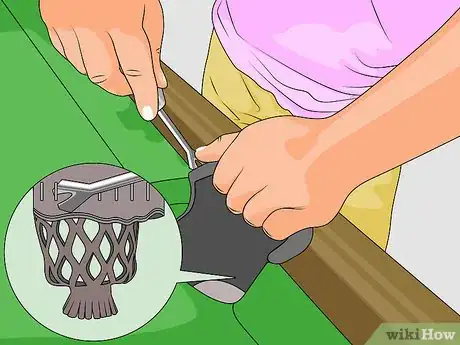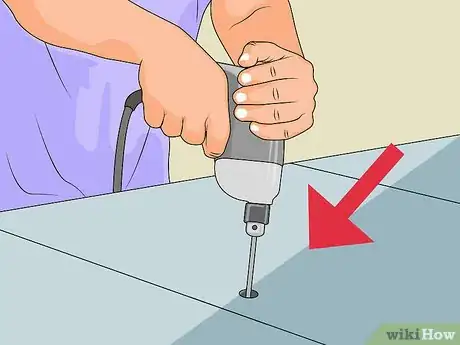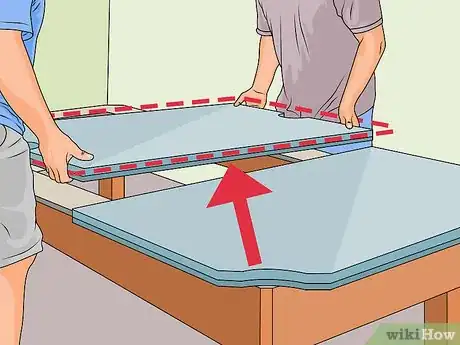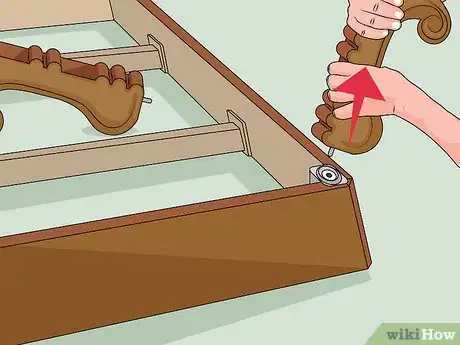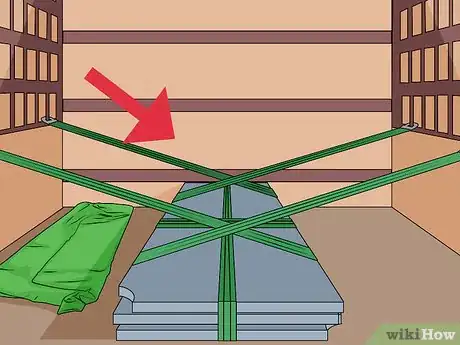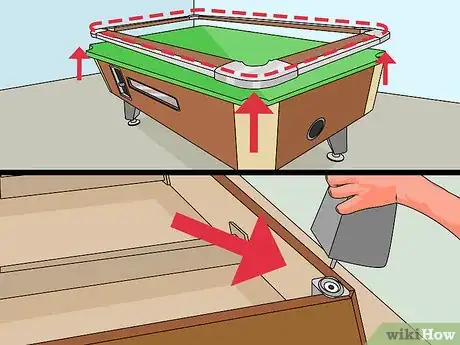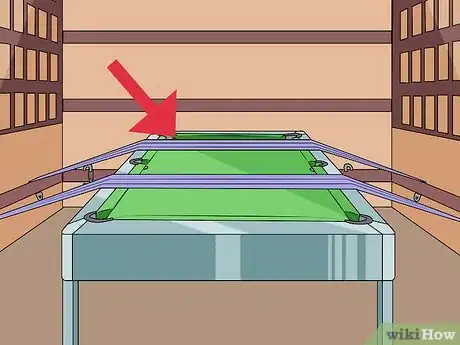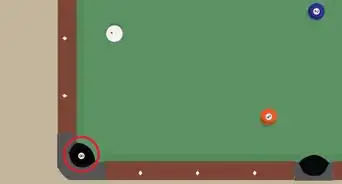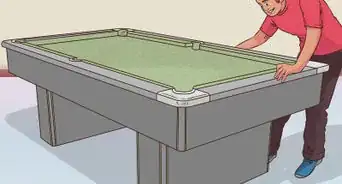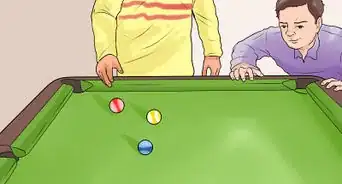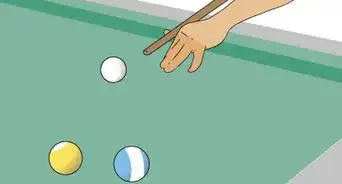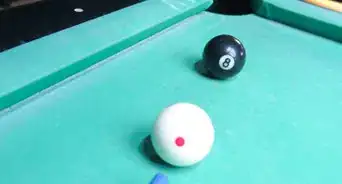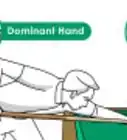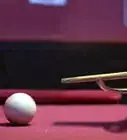This article was co-authored by wikiHow Staff. Our trained team of editors and researchers validate articles for accuracy and comprehensiveness. wikiHow's Content Management Team carefully monitors the work from our editorial staff to ensure that each article is backed by trusted research and meets our high quality standards.
There are 7 references cited in this article, which can be found at the bottom of the page.
wikiHow marks an article as reader-approved once it receives enough positive feedback. This article received 13 testimonials and 86% of readers who voted found it helpful, earning it our reader-approved status.
This article has been viewed 287,703 times.
Learn more...
Disassembling a pool table takes the right tools and a fair amount of muscle. A standard home pool table has a wood frame, heavy slate bed, and leather drop pockets. Coin-operated tables, tables with ball return mechanisms, and tables with a fiberboard surface are much harder to take apart.
Steps
Standard Slate Table
-
1Detach the pockets from the table. Remove the pocket liners if present. Remove the screws or staples that attach the pocket straps to the table. If you don't have a staple remover, pry the staples out with a flathead screwdriver. Leave the pockets in place for now.
- This is usually easier from under the table. Wear goggles to protect against falling staples.[1]
-
2Remove the rail bolts underneath each rail. There are usually three or four bolts under each rail.[2] Remove them with a socket wrench.
- Old pool tables may have special bolts with two holes. To remove these, order a forked tool from a pool table supply store.
Advertisement -
3Remove the rails and pockets. Pull apart any rail sections that detach easily and set them aside. If two rails are attached at a corner, flip them over onto the table with another person's help, then pull apart the two sections. Set aside the pockets as well.
- Set the rails down carefully when flipping them, and take care to avoid bashing the side pockets.[3]
-
4Detach the felt from the slate bed. The felt is usually either glued down or stapled to the wood backing of the slate. If it is stapled, remove each staple carefully to avoid tears. If glued, pull the edge of the felt backward very gently (never up or forward), working your way around the table.[4] Once you've removed the felt, fold it carefully. To avoid wrinkles and creases, do not press the fold lines.[5]
- If the felt is wearing out, consider tearing it off and installing new felt during reassembly.
-
5Remove the slate screws with a drill. These screws are usually at the corners of the table, but could be along the sides and center beam as well.[6]
- If you find beeswax or putty over the screws, carefully scrape it off with a screwdriver to reveal the screw head without scratching the slate.
-
6Lift each slate and place to the side. Most tables have a playing surface made from three slate slabs, and each one can weigh 250 lbs (110 kg).[7] Get a couple friends to help out and move them as carefully as possible. A scratch or chip in one slate could ruin the table, requiring an expensive replacement for all three slates.[8]
- One-piece slates can weigh up to 800 lbs (360 kg).[9] Enlist several strong people to help you move these.
-
7Disassemble the frame. Flip the table over and unbolt the legs. Take apart the final lightweight pieces, and you're ready to go.
-
8Transport the slate carefully. The most difficult part to transport is the slate tabletop, which is both heavy and fragile. Recruit several strong people to load the slate onto a furniture dolly, on its side. Fasten the slate in place tightly with a furniture strap. If transporting by truck, fasten the strap around the slate and onto the truck slats.[10] If at all possible, load it into the truck using a liftgate.
- If you put the pool table in storage, choose a climate controlled storage unit, or a room with minimal variation in temperature and humidity. Lay the slate onto plastic sheeting, and tape more plastic sheeting over it. Store the carefully folded felt in a sealed plastic bag, and all other components in moving blankets or other protective materials.
Mechanized or Non-Slate Pool Table
-
1Remove only the rails and legs from a coin-operated table. Remove the rail bolts with a socket wrench and detach them from the table. If two lengths of rail are connected at a corner, you may need to flip them over before you detach them gently. Carefully flip the table over and unbolt the legs. Do not attempt to disassemble the rest of the table without professional help, since removing the coin-operated mechanism can make reassembly difficult or impossible.
- Some Valley Dynamo coin-operated tables have a metal trim covering the rail bolts. Remove the screws holding the trim in place, slide the trim toward the corner, then lift them up and out.
-
2Use caution with ball return systems. Most tables with a ball return system are also coin-operated, but some tables from the 1970s or '80s have a simpler mechanism.[11] In some models, removing the mechanism without damaging the table is difficult.[12] Unless you have a manual for your model, leave the ball return mechanism attached during transport.
- You can usually disassemble the rest of the table as described in the standard slate table instructions.
-
3Transport non-slate tables in one piece. If your pool table surface is made from fiberboard (MDF), wood, or any other non-slate material, it is most likely a low-cost "disposable" table. These are not usually meant to be disassembled, not even by a professional.[13] Transport the table in one piece.
- Some of these tables have folding legs to make transport easier.
Community Q&A
-
QuestionHow many slates do I need for a pool table? How much do they weigh?
 Community AnswerGenerally pool tables will have 3 pieces of one-inch slate, weighing 100-300 lbs each.
Community AnswerGenerally pool tables will have 3 pieces of one-inch slate, weighing 100-300 lbs each. -
QuestionWhat does the ball return configuration look like on a coin operated table?
 Community AnswerIt varies by manufacturer, but generally open chutes fashioned from metal rails or troughs that mount on the wooden table pieces or other location-designed braces to keep all the troughs at the correct angles to feed the balls to the return tray. Once the upper playing bed is removed, the chutes can be removed, repaired, or disassembled; but, every piece should be labelled as to it's exact orientation and placement to be able to reassemble it. It's not recommended, as any bending of the rails or misalignment of the attachment points can cause problems such as balls jumping the rails or getting stuck during play. Not fun.
Community AnswerIt varies by manufacturer, but generally open chutes fashioned from metal rails or troughs that mount on the wooden table pieces or other location-designed braces to keep all the troughs at the correct angles to feed the balls to the return tray. Once the upper playing bed is removed, the chutes can be removed, repaired, or disassembled; but, every piece should be labelled as to it's exact orientation and placement to be able to reassemble it. It's not recommended, as any bending of the rails or misalignment of the attachment points can cause problems such as balls jumping the rails or getting stuck during play. Not fun.
Glossary
- Bumpers: The rubber part of the rail. They are covered with felt.
- Rail Assembly: Contains the wooden rail, the cushion or bumpers and to which the apron attaches to.
- Felt: The cloth that covers the playing surface and the rail bumpers. Usually it is a 75% wool 25% nylon blend.
- Aprons: The wooded segment that attached to the rail assembly.
- Slate: The playing surface of the pool table. Usually comes in (3) pieces. Can either be wood backed or unbacked.
- Frame: The base of the pool table which the slate sits on.
Things You'll Need
- Socket and socket wrench (usually 9/16")
- Philips screwdriver
- Flat head screwdriver
- Marked sandwich baggies to place screws and bolts.
- Drill with screwdriver bit
References
- ↑ http://www.mymovingreviews.com/move/move-a-pool-table-by-yourself
- ↑ http://www.doityourself.com/stry/how-to-dismantle-a-pool-table
- ↑ http://www.doityourself.com/stry/how-to-dismantle-a-pool-table
- ↑ http://www.mymovingreviews.com/move/move-a-pool-table-by-yourself
- ↑ http://www.doityourself.com/stry/how-to-dismantle-a-pool-table
- ↑ http://www.doityourself.com/stry/how-to-dismantle-a-pool-table
- ↑ http://www.mymovingreviews.com/move/move-a-pool-table-by-yourself#pool-table-disassembly
- ↑ http://blog.flatrate.com/how-to-move-pool-table/#.V9c0L7V2F8A
- ↑ http://www.mymovingreviews.com/move/move-a-pool-table-by-yourself
About This Article
To disassemble a standard slate pool table, start by detaching the pockets by removing the screws or staples holding them in place. Then, remove the rail bolts underneath each rail using a socket wrench, and lift the rails off of the table. Next, remove the felt on the table by pulling out the staples or carefully peeling it off if it's glued down. Finally, unscrew and lift off the slate bed before disassembling the wooden frame. To learn how to disassemble a mechanized or non-slate pool table, scroll down!
